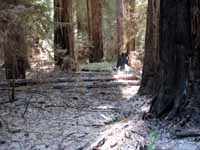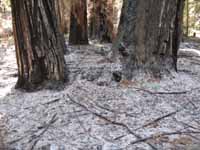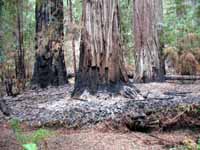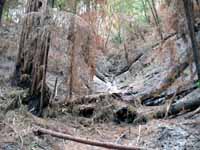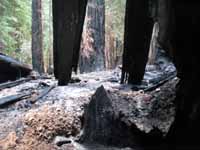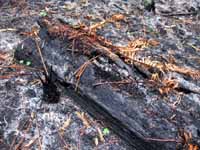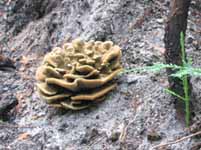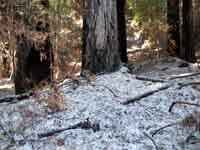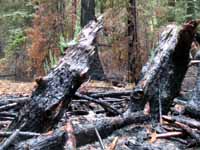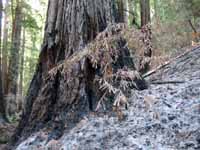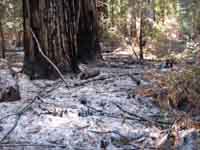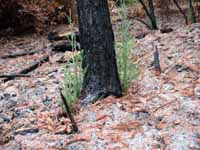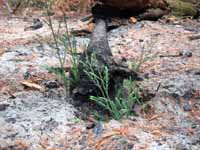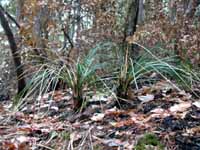|
Orr Fire Case Study
Montgomery Woods State Reserve
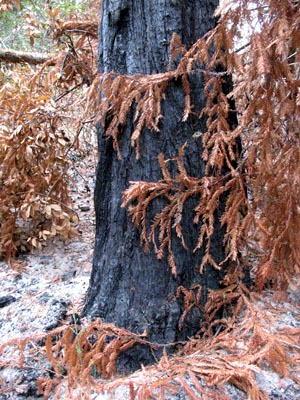 Montgomery Woods State Reserve is located at the eastern edge of the coast redwood range between the Mendocino Coast and the town of Ukiah. The site's peculiar hydrology has provided Montgomery Flat with one of the most spectacular old growth redwood groves that exists. Montgomery Woods State Reserve is located at the eastern edge of the coast redwood range between the Mendocino Coast and the town of Ukiah. The site's peculiar hydrology has provided Montgomery Flat with one of the most spectacular old growth redwood groves that exists.
The Fire Event
In June of 2008, an unusual early season lightning storm ignited fires all along the north coast, including at least one fire within Montgomery Woods State Natural Reserve and it started several others nearby. During the next few weeks, these fires came together to cover a significant portion of the Reserve including the mid-slope alluvial flat which harbors some of the tallest trees on Earth.
The fire is significant for two reasons: (1) it is one of the few largest landscape fires to have burned in coast redwood, and (2) it burned during the early summer and this seems to have led to fire effects that are notably different from what was observed after the 2003 Canoe fire 120 km to the north. Given the previous rarity of such large fires and the fire season, the Orr Series can provide researchers and managers with critical knowledge about the importance of burn season on coast redwood ecosystems.
This June 21st lightning storm was unusual because such events typically occur much later in the summer. Early season fire has historically been associated with human ignitions. Fire personnel believe that they have identified one tree that had been struck on the Montgomery Woods Flat. It was a centuries-old tree with a massive basal cavity that lost its top piece by piece before burning out from below. Other ignitions also occurred within the fire perimeter. Over the following weeks, these ignitions coalesced to form a 3,750 acre (1,520 ha) fire known as the Orr Complex (see maps below). Had the Orr Series and surrounding fires not been extinguished, they would have likely burned together and covered tens of thousands of acres.
June 25, 2008 |
June 27, 2008 |
June 29, 2008 |
July 2, 2008 |
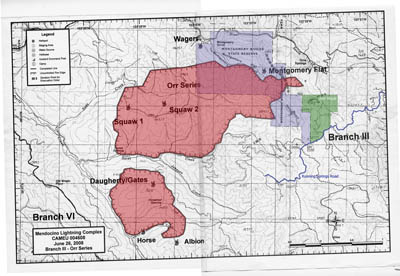 |
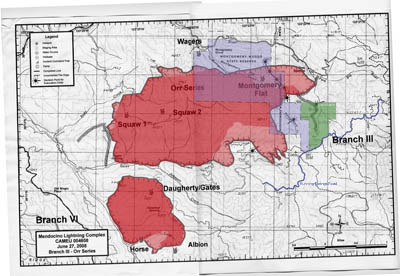 |
 |
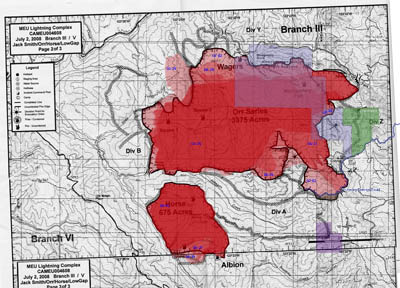 |
Fire Ecology
While researchers have made great inroads toward understanding coast redwood's peculiar response to fire over recent decades, our insights from fires that occur after extended periods of fire exclusion may not be representative of the way that fires burned in the past. The Orr Series burned so early in the season that burning conditions were mild, and fire effects may be more reminiscent of fires of the past than late season events.
To the casual visitor, the stark loss of greenery may be overwhelming. Huckleberries and low branching tanoaks were scorched to light brown. The ground has lost its rich mantle of ferns and now lies covered beneath a wintry cover of white ash. This snow-like covering of combusted needles and twigs will last until the winter rains carry it down into the soil.
Looking upward, there has been very little change, except where a few trees collapsed. In the coming winter and in following years, it will be interesting to see if there is much delayed mortality. Such gradual death was common among Douglas fir after the 2003 Canoe fire, and death continued even five years later. The death-risk to old-growth redwood results from the loss of supporting wood in trees with basal cavities. Four to twelve inches of cavity recession is common at the bases of large trees, not unlike what was observed following the Canoe fire. As the soil becomes saturated by rain and flooding this first winter, leaning trees with basal cavities are susceptible to collapse.
These photographs were taken on September 18-19, 2008; some during the second light rain of the summer.
The Orr Fire and Canoe Fire Compared: A Preliminary Effects Assessment
|
CANOE FIRE (2003) |
ORR SERIES (2008) |
Latitude |
40 deg. 17 min. N |
39 deg. 13 min. N |
Distance from the coast |
About 35 km |
About 35 km |
Cause |
Lightning storm event |
Lightning storm event |
Season |
Late (Sep 3-Oct 3) |
Early (Jun 21- ~Jul 10) |
Pre-exclusion fire history |
Based on analysis of fire scars, the last fire burned between the late 1910s and 1930s.
Prior fires burned with similar 10-15 year frequencies regardless of topographic position. The Native Lolangkok occupied these forests for centuries and spent their winters on the alluvial flats. |
Preliminary data indicate that Montgomery Flat burned slightly more often than did Humboldt Redwoods since the late 1700s. Prior to the Orr Series event, char was ubiquitous on trees and it likely burned sometime in the 1960s. The lower fire severity observed here may have resulted from there being less surface fuel. |
Understory mortality |
Most sword ferns died and had not recovered 5 years later. Huckleberries were top-killed anywhere that fire passed under them; they quickly respouted. |
Most sword and chain ferns resprouted after two months. Huckleberries were top-killed anywhere that fire passed under them; they quickly resprouted. |
Understory patchiness |
Generally resulted in nearly uniform coverage on flats and slopes where sword ferns or huckleberries occurred. The only exceptions were stream and gully banks, the occasional uprooted root mass and where pockets of fallen buckskinned logs prevented fire spread. |
Irregular fire coverage both on chain fern and sword fern dominated portions of Montgomery Flat and on huckleberry-dominated slopes. Fire did not burn over a sizable area within the fire perimeter (roughly 5-20 percent). |
Mid-story |
Tanoak mortality from scorching heat was common and was highly patchy. Resprouting was ubiquitous in 2004 and has continued. |
Tanoak mortality from scorching occurred, but appears to have been less frequent. Dead and yet- living stems have sprouted. |
Redwood bark burnback
|
Bark loss was highly variable among trees, but severe burnback was common and it led to extensive scarring. |
Generally basal bark loss was far less extreme and frequent here than seen in the Canoe fire. Cambial mortality was probably more spotty. |
Redwood cavity enlargement and collapse |
Cavity burnout was severe and this led to the loss and increased susceptibility of numerous old growth trees. Large trees continued to fall through the winter. |
Cavity burnout appears to have been similar or less here than seen in the Canoe fire. A relatively low percentage of large redwoods appear to have fallen.
|
Old Douglas Fir |
Douglas fir collapse was frequent and numerous immediate survivors were dying in 2008.
|
Douglas fir collapse occurred, but preliminarily observations suggest that it appears to be less common than in the Canoe fire.
|
Related Pages:
Steve Norman
|
|







